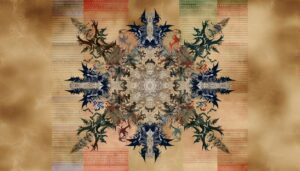How to Draw Symbols for Earth Air Fire and Water
Symbols for Earth, Air, Fire, and Water hold profound historical and cultural significance. Originating from ancient Greek philosophy by thinkers like Empedocles and Aristotle, these elements were considered the essential building blocks of nature.
In alchemical traditions, they symbolized fundamental energies and archetypes representing stability (Earth), intellect (Air), transformation (Fire), and emotion (Water). These symbols persist in modern spirituality, reflecting our connection to the cosmos and inner self.
To understand their evolution through medieval and Renaissance alchemy, and their enduring impact, one must explore their rich symbolic tapestry further.
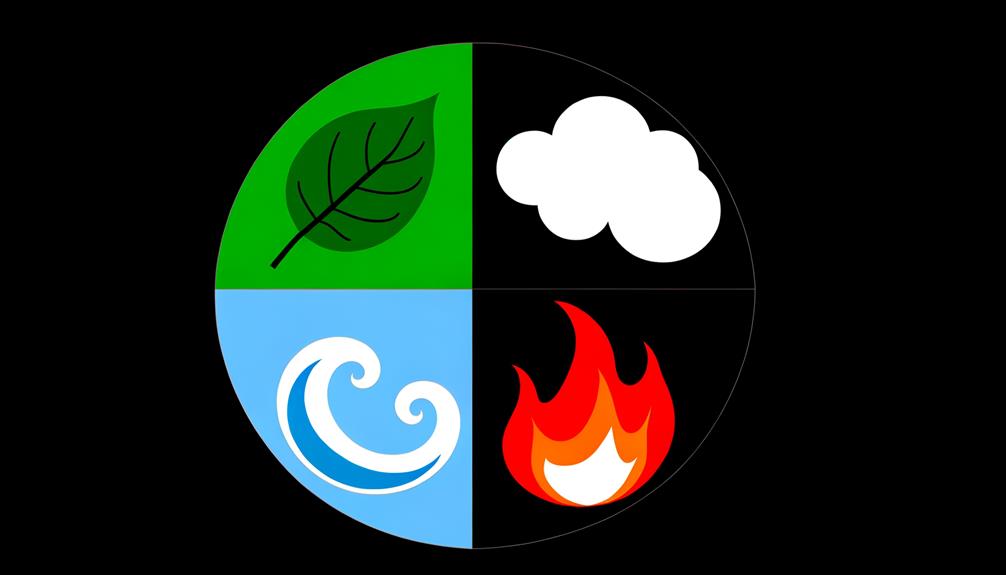
Key Takeaways
- Earth is commonly symbolized by an inverted triangle with a horizontal line through it.
- Air is often represented by an upright triangle with a horizontal line through it.
- Fire is symbolized by an upright triangle.
- Water is represented by an inverted triangle.
- These symbols are rooted in ancient philosophies and alchemical traditions.
Historical Origins
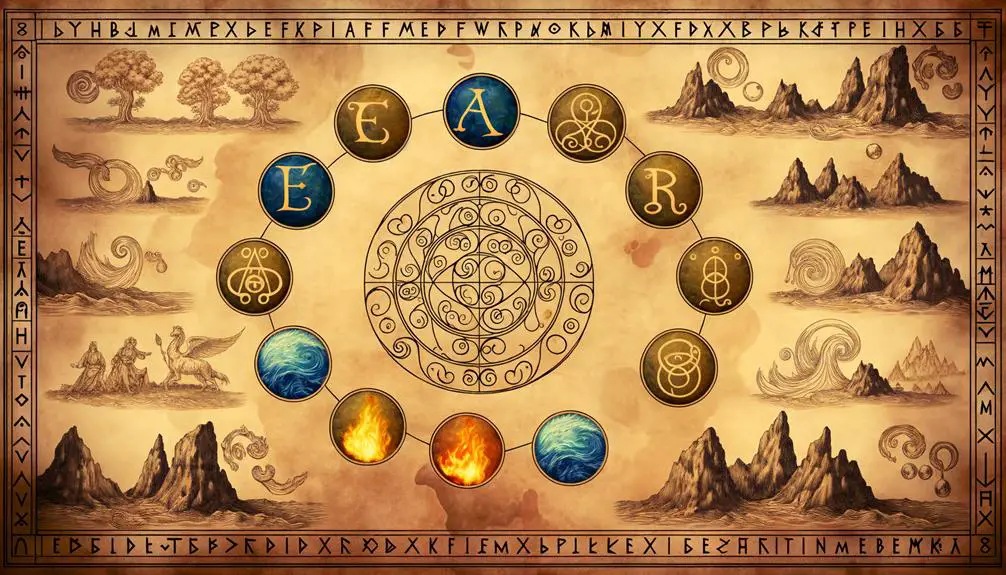
In ancient civilizations, the symbolic representation of the four classical elements—Earth, Air, Fire, and Water—emerged as foundational concepts in both philosophy and early scientific thought. These elements were believed to constitute the fundamental building blocks of the natural world.
In Ancient Greece, philosophers like Empedocles and Aristotle theorized that these elements explained the complexity of nature. Similarly, in ancient India, the concept of 'Pancha Bhoota' delineated Earth, Air, Fire, Water, and Ether. These symbols held archetypal significance, reflecting humanity's attempt to categorize and comprehend the universe.
Cultural narratives across civilizations imbued these elements with profound meanings, shaping rituals, medical practices, and metaphysical beliefs. Therefore, their enduring legacy highlights their pivotal role in humanity's quest for understanding.
Symbolism in Alchemy
In the domain of alchemy, the symbolism of Earth, Air, Fire, and Water has its roots in ancient philosophies, evolving notably through the Middle Ages.
These elements were not only seen as fundamental building blocks of the physical world but also as archetypal representations of various aspects of human experience and the cosmos.
The cultural importance of these symbols is profound, influencing everything from early scientific thought to the esoteric and mystical traditions that shaped Western spiritual and intellectual history.
Origins and Evolution
Rooted in ancient philosophies, the symbolism of Earth, Air, Fire, and Water in alchemy represents both the physical elements and their deeper metaphysical qualities. This symbolism traces back to the classical Greek tradition and evolves through medieval alchemical practices. The Greek philosopher Empedocles identified these four elements as fundamental constituents of the universe. Alchemists later imbued these elements with symbolic meanings that extended beyond their physical properties.
Key evolutionary stages include:
- Greek Philosophy: Empedocles and Aristotle's foundational theories on the elements.
- Medieval Alchemy: Integration of spiritual and mystical interpretations by figures such as Paracelsus.
- Renaissance Revival: Hermetic texts renewed interest in alchemical symbolism, blending science and mysticism.
These stages underscore the enduring cultural significance of elemental symbolism.
Elemental Representations
Throughout alchemical traditions, the symbols for Earth, Air, Fire, and Water have served as archetypal representations of both physical and metaphysical principles, reflecting their profound cultural and spiritual significance. These symbols encapsulate the essence of natural phenomena and the human quest for transformation and enlightenment. Alchemists believed these elements were the foundational building blocks of the universe, each with unique properties and symbolic meanings.
| Element | Symbol |
|---|---|
| Earth | �� |
| Air | �� |
| Fire | �� |
| Water | �� |
Earth symbolizes stability and fertility, Air represents intellect and communication, Fire denotes energy and transformation, and Water signifies emotion and intuition. These symbols are not mere icons but gateways to understanding the interconnectedness of nature and human experience.
Earth Symbol Meaning

The Earth symbol, often depicted as an inverted triangle with a horizontal line through it, has historically embodied the archetype of stability, fertility, and the nurturing aspects of nature across various cultures. This emblem has traversed diverse civilizations, representing the material world and physical reality. Its significance can be delineated through three primary aspects:
- Stability: In ancient Greek philosophy, Earth was considered the most solid and dependable of elements, grounding other forces.
- Fertility: In agrarian societies, Earth was revered as the life-giving force, essential for crop growth and sustenance.
- Nurturing: Many mythologies depict Earth as a motherly figure, such as Gaia in Greek mythology, symbolizing protection and nourishment.
This enduring symbol continues to resonate within modern interpretations of elemental balance.
Air Symbol Meaning
How has the Air symbol, often represented by an upright triangle with a horizontal line through it, encapsulated the qualities of intellect, movement, and communication across various cultures and historical periods?
In ancient Greek philosophy, Air was associated with the mind and the soul, signifying clarity and thought.
Alchemists in medieval Europe viewed Air as a symbol of life and transformation, essential for processes like breathing and combustion.
In Hinduism, the element Air, or 'Vayu,' is linked to the essential life force, or 'prana,' underscoring its importance in sustaining life.
Across these diverse contexts, the Air symbol consistently represents the ethereal and dynamic aspects of existence, embodying the unseen forces that drive intellect, innovation, and connectivity.
Fire Symbol Meaning
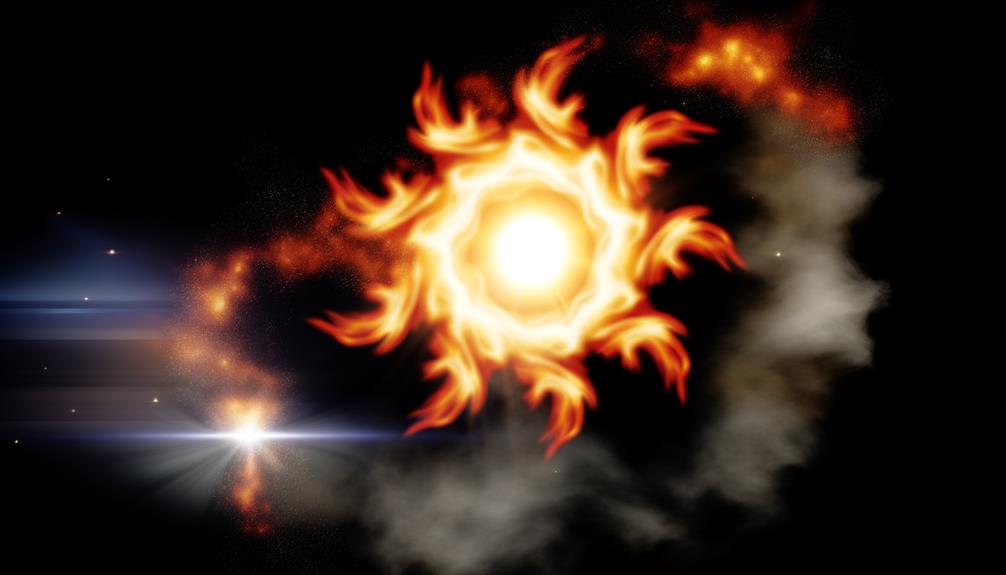
The symbol of fire has held profound significance across various cultures throughout history, often representing transformation, destruction, and renewal.
In alchemical traditions, fire is perceived as an essential element in the transmutation process, embodying purification and enlightenment.
Contemporary uses of the fire symbol continue to evoke its archetypal power, manifesting in everything from spiritual rituals to modern literature and art.
Ancient Cultural Significance
In ancient cultures, the symbol of fire often represented transformation, energy, and the divine spark of life. Its significance permeated various civilizations, reflecting its multifaceted nature:
- Greek Mythology: Prometheus stole fire from the gods, symbolizing knowledge and human advancement.
- Hinduism: Agni, the fire god, is central to rituals, embodying purification and the divine intermediary.
- Chinese Philosophy: The fire element in the Five Phases (Wu Xing) denotes dynamism, growth, and the summer season.
These cultural perspectives highlight how fire transcended mere physicality to embody profound metaphysical meanings.
Alchemical Representation Insights
Building on the profound cultural significance of fire, its alchemical representation further elucidates its symbolic essence as a transformative and purifying force.
In alchemy, fire is often depicted as an upward-pointing triangle, symbolizing its ascendant nature. This geometric form reflects fire's inherent qualities of energy, ambition, and enlightenment.
Historically, alchemists associated fire with the process of calcination, where substances are heated to break down impurities, mirroring the human journey toward spiritual purification.
Fire's archetypal role as both a creator and destroyer underscores its dual capacity to initiate growth and to bring about necessary endings.
Hence, the alchemical symbol of fire encapsulates its dynamic and potent influence within the material and spiritual domains, embodying perpetual transformation and renewal.
Modern Symbolism Uses
Modern interpretations of the fire symbol continue to draw from its historical roots, emphasizing its archetypal role as a catalyst for change and a source of essential energy.
In contemporary contexts, the symbol of fire is often employed to represent:
- Transformation: Fire's ability to convert substances through combustion mirrors personal and collective transformation.
- Passion: Its intense, unyielding nature symbolizes the fervent emotions and drive that propel human endeavors.
- Destruction and Renewal: Fire's duality as both a destructive and purifying force highlights the cyclical nature of life and rebirth.
These modern uses reflect fire's enduring cultural significance, underscoring its role in both historical narratives and present-day symbolic frameworks.
This persistence of meaning attests to fire's profound impact on human consciousness and societal development.
Water Symbol Meaning
Historically, the water symbol has been associated with fluidity, intuition, and the subconscious, representing a profound connection to emotions and the cycles of life.
In various cultures, water embodies the essence of creation and destruction, symbolizing purification and renewal. Jungian archetypes link it to the unconscious mind, where hidden thoughts and feelings reside.
The ancient Greeks revered water as one of the four classical elements essential for existence, while in Taoism, it epitomizes softness and adaptability, mirroring the path of least resistance.
Water's cultural significance extends to religious rituals, where it is often employed in ceremonies of cleansing and spiritual rebirth. This multifaceted symbol continues to resonate deeply, encapsulating the ever-changing nature of human experience.
Use in Astrology
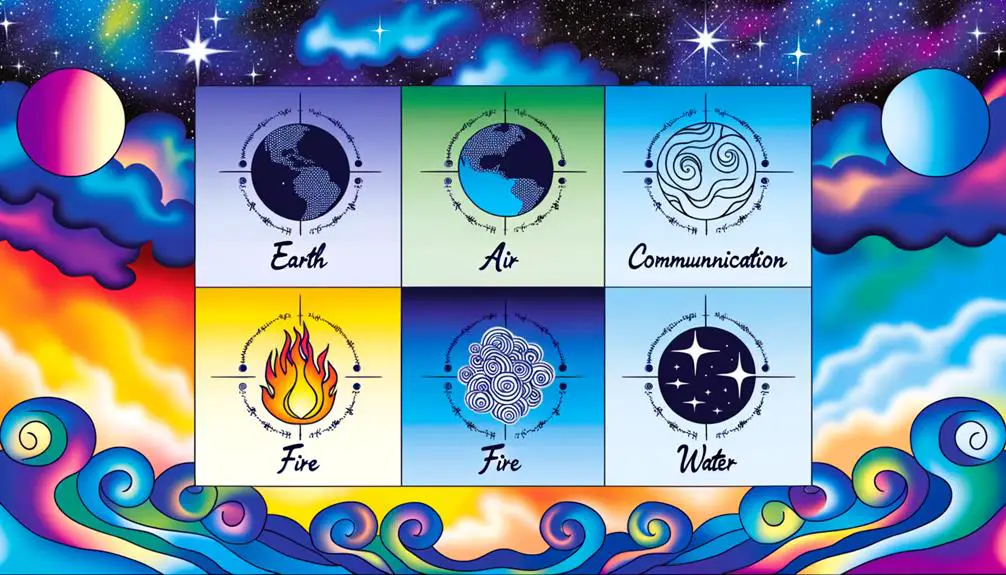
Astrology integrates the symbols of Earth, Air, Fire, and Water to represent the fundamental energies influencing human behavior and the natural world.
Historically, these elements were central to classical astrology, each embodying distinct archetypal qualities:
- Earth: Stability and practicality, linked to signs like Taurus, Virgo, and Capricorn.
- Air: Intellect and communication, associated with Gemini, Libra, and Aquarius.
- Fire: Passion and transformation, symbolized by Aries, Leo, and Sagittarius.
These elemental symbols offer a framework for understanding the intrinsic characteristics and behavioral tendencies of individuals.
Culturally, their significance transcends astrology, appearing in various mythologies and philosophies, underscoring their universal applicability.
This elemental system aids astrologers in interpreting the complex interplay of cosmic forces shaping human experience.
Modern Spirituality
In contemporary spirituality, the symbols of Earth, Air, Fire, and Water continue to embody profound archetypal energies that guide personal growth and self-awareness.
Historically, these elements have been cornerstones in various cultural and mystical traditions, representing foundational aspects of existence.
Earth symbolizes stability and grounding, Air denotes intellect and communication, Fire signifies transformation and passion, while Water embodies emotion and intuition.
Modern spiritual practices incorporate these elements to facilitate holistic healing and balance.
Rituals, meditations, and artistic expressions often invoke these symbols to connect individuals with the natural world and their inner selves.
Conclusion
The ancient symbols for earth, air, fire, and water serve as enduring archetypes, weaving through the tapestry of human history like elemental threads.
Alchemy's rich symbolism, astrology's celestial dance, and modern spirituality's quest for meaning all find resonance in these primordial icons.
These symbols, each a gateway to deeper understanding, illustrate humanity's timeless endeavor to comprehend the natural world and its mysteries, echoing through cultures and epochs like whispers from the very fabric of existence.




